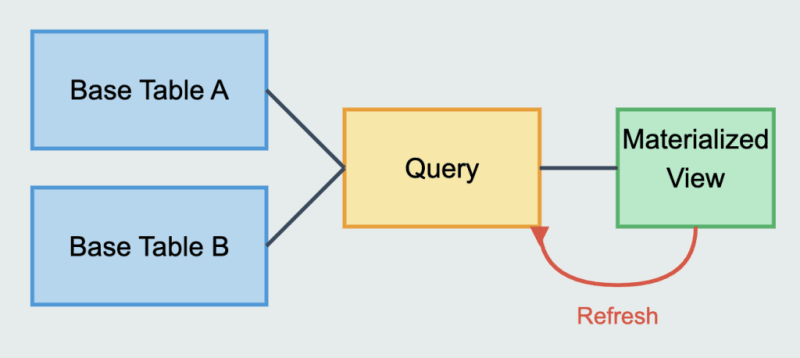物化視圖是資料庫管理中的重要功能,可顯著提高查詢效能和資料檢索效率。雖然 MySQL 不像其他一些資料庫系統那樣本身支援物化視圖,但有一些有效的解決方法可以實現類似的功能。本文深入探討了什麼是物化視圖、它們的優點以及如何在 MySQL 中實現它們。
物化視圖是包含查詢結果的資料庫物件。與每次查詢時動態產生結果的標準視圖不同,物化視圖物理儲存查詢結果數據,從而提高複雜和資源密集型查詢的效能。
讓我們用這張圖來解釋物化視圖的概念:

物化視圖是包含查詢結果的資料庫物件。與每次存取時執行查詢的常規視圖不同,物化視圖像表一樣物理儲存結果集。這有幾個優點:
物化視圖需要在查詢效能和資料新鮮度之間進行權衡。它們提供快速的查詢結果,但代價是刷新之間可能會出現稍微過時的資料。
雖然MySQL本身不支援物化視圖,但您可以使用表格和觸發器的組合來實現它們。以下是如何在 MySQL 中建立物化視圖的逐步指南:
首先,建立一個用於儲存物化視圖資料的基底表。
<span>CREATE TABLE materialized_view AS</span><br> <span>SELECT column1, column2, aggregate_function(column3)</span><br> <span>FROM base_table</span><br> <span>GROUP BY column1, column2;</span>
為了確保物化視圖與基底表保持同步,您需要為 INSERT、UPDATE 和 DELETE 作業建立觸發器。
<span>CREATE TRIGGER trg_after_insert AFTER INSERT ON base_table</span><br> <span>FOR EACH ROW</span><br> <span>BEGIN</span><br> <span> INSERT INTO materialized_view (column1, column2, column3)</span><br> <span> VALUES (NEW.column1, NEW.column2, NEW.column3);</span><br> <span>END;</span>
<span>CREATE TRIGGER trg_after_update AFTER UPDATE ON base_table</span><br> <span>FOR EACH ROW</span><br> <span>BEGIN</span><br> <span> UPDATE materialized_view</span><br> <span> SET column1 = NEW.column1, column2 = NEW.column2, column3 = NEW.column3</span><br> <span> WHERE id = OLD.id;</span><br> <span>END;</span>
<span>CREATE TRIGGER trg_after_delete AFTER DELETE ON base_table</span><br> <span>FOR EACH ROW</span><br> <span>BEGIN</span><br> <span> DELETE FROM materialized_view WHERE id = OLD.id;</span><br> <span>END;</span>
根據應用程式的要求,您可能需要定期刷新物化視圖以確保它反映最新的資料。這可以使用計劃的事件或 cron 作業來完成。
<span>CREATE EVENT refresh_materialized_view</span><br> <span>ON SCHEDULE EVERY 1 HOUR</span><br> <span>DO</span><br> <span>BEGIN</span><br> <span> TRUNCATE TABLE materialized_view;</span><br> <span> INSERT INTO materialized_view (column1, column2, aggregate_function(column3))</span><br> <span> SELECT column1, column2, aggregate_function(column3)</span><br> <span> FROM base_table</span><br> <span> GROUP BY column1, column2;</span><br> <span>END;</span>
使用快速資料庫產生器的物化視圖
雖然理解 SQL 和執行高效查詢至關重要,但建立完整的資料庫需要大量的 SQL 知識。這就是像 Five 這樣的快速資料庫建構器發揮作用的地方。
In Five, you can define your database schema using MySQL, including advanced operations. Five provides a MySQL database for your application and generates an automatic UI, making it easier to interact with your data.
With Five, you can create forms, charts, and reports based on your database schema. This means you can build interfaces that interact with data fields.
For example, if you have a complex query that aggregates data from multiple tables, you can create a materialized view to store the results of this query. This can significantly speed up your application by reducing the load on your database and providing quicker access to frequently queried data:
Five also allows you to write custom JavaScript and TypeScript functions, giving you the flexibility to implement complex business logic. This is crucial for applications that require more than just standard CRUD (Create, Read, Update, Delete) operations.
Once your application is built, you can deploy your application to a secure, scalable cloud infrastructure with just a few clicks. This allows you to focus on development without worrying about the complexities of cloud deployment.
If you are serious about working with MySQL give Five a try. Sign up for free access to Five’s online development environment and start building your web application today.
<strong>Build Your Database In 3 Steps</strong><br><span>Start Developing Today</span>
Get Instant Access

Although MySQL does not support them natively, you can effectively implement materialized views using tables and triggers. By understanding and utilizing materialized views, you can significantly enhance the performance and scalability of your MySQL database applications.
Q: Does MySQL support materialized views natively?
No, MySQL does not support materialized views natively, but you can achieve similar functionality using tables and triggers.
Q: How often should I refresh my materialized view?
The refresh frequency depends on your application’s requirements. For real-time applications, you might need more frequent updates, while less frequent updates might suffice for batch processing applications.
Q: What are the alternatives to materialized views in MySQL?
Alternatives include using temporary tables, cache tables, or optimizing queries through indexing and query restructuring.
以上是MySQL 物化視圖綜合指南的詳細內容。更多資訊請關注PHP中文網其他相關文章!




